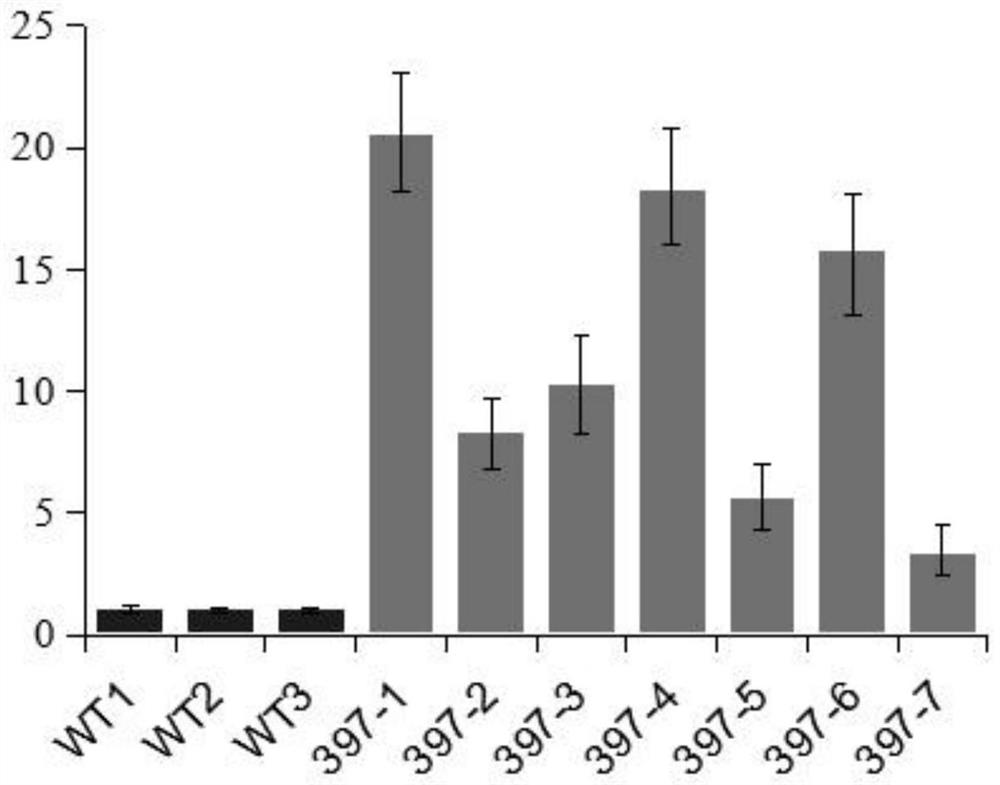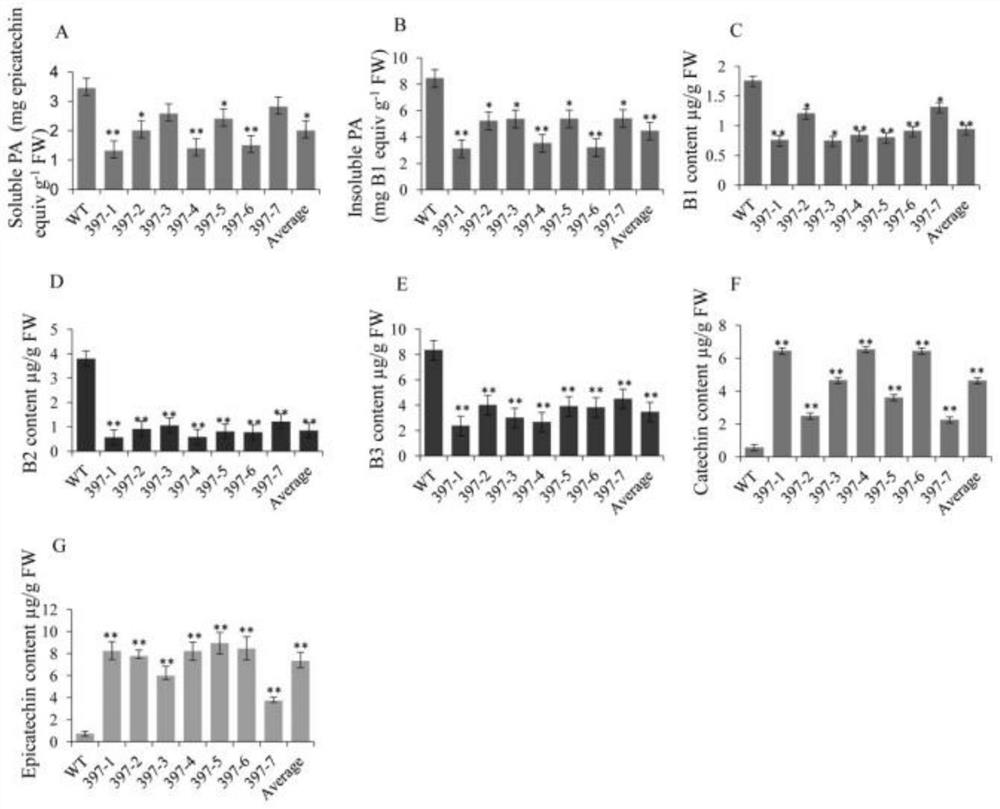Gene SmLAC1 and application of gene SmLAC1 in regulation and control of synthesis of procyanidine
A proanthocyanidin and gene technology, which is applied in the fields of genetic engineering and molecular biology, can solve the problems that the mechanism of PA oxidation polymerization is not clear, and the comprehensive understanding of PA polymerization mechanism is in its infancy.
- Summary
- Abstract
- Description
- Claims
- Application Information
AI Technical Summary
Problems solved by technology
Method used
Image
Examples
Embodiment 1
[0027] Changes of proanthocyanidin content in salvia miltiorrhiza overexpressing miR397:
[0028] The expression vector pBI121-Ptr-miR397a was transformed into Agrobacterium GV3101 by freeze-thaw method, and a total of 7 transgenic lines were obtained, and the relative expression level of miR397 in the Danshen transgenic lines transfected with pBI121-Ptr-miR397a was detected by fluorescence quantitative PCR changes (such as figure 1 ), the results showed that, compared with the wild-type Salvia miltiorrhiza plants, the expression level of miR397 in the overexpressed Salvia miltiorrhiza plants transformed with pBI121-Ptr-miR397a was significantly increased;
[0029] Proanthocyanidins were extracted by acetone extraction method, extractant: 70% acetone and 0.5% acetic acid, 0.1g of Salvia miltiorrhiza was ground with liquid nitrogen, added the extractant, ultrasonicated in ice water at room temperature for 30 minutes, centrifuged at 10000rpm for 5 minutes, and the precipitate wa...
Embodiment 2
[0039] Clone Danshen laccase SmLAC1 gene and construct Escherichia coli expression vector:
[0040] Firstly, the transcriptomes of miR397-overexpressed Salvia miltiorrhiza and wild Salvia miltiorrhiza were deeply sequenced, and then, according to the screening of differentially expressed genes in flowers, the target gene laccase gene whose expression was significantly decreased in flowers was determined, and the candidate genes were identified by in vitro enzyme activity identification function;
[0041] The prokaryotic expression vector was constructed by enzyme-cut ligation, primers were designed using primer premier 5.0 (PP5), and designed according to the recommendations of the PP5 software. When designing the primers, restriction sites were added to the primers at both ends of the full-length SmLAC1 (indicated by underline );
[0042] F: GCGGCCGC ATGGAGCGCTCTTTGATGTTTTCAGCATG, as shown in SEQ ID NO.3;
[0043] R: GGATCC GCACTTGGGAAAATCAGCCGGCGGCGG, as shown in SEQ ID ...
Embodiment 3
[0059] In the prokaryotic system, it was verified that the SmLAC1 protein can catalyze the function of flavan-3-ol:
[0060] Expression of SmLAC1 gene in prokaryotic E. coli
[0061] The prokaryotic expression vector pET30a-SmLAC1 was transformed into the Escherichia coli Rosetta2 (DE3) strain by chemical transformation to obtain the Escherichia coli strain containing the target gene, and the empty plasmid was transformed at the same time as a negative control. Grow overnight at 37°C on prime LB solid medium, and select positive clones for subsequent experiments;
[0062] Then pick positive single clones and grow overnight at 37°C in 2 mL of LB liquid medium containing 100 mg / L kanamycin, and then inoculate into 50 mL of LB liquid medium containing 100 mg / L kanamycin, 37 Cultivate the OD600 to 0.5 at ℃, add IPTG with a final concentration of 0.1-0.5mM for induction, 20℃-25℃, 150-180rpm, after induction for 8-12h, place the induced cultured bacterial solution in a 4℃ refrigera...
PUM
 Login to View More
Login to View More Abstract
Description
Claims
Application Information
 Login to View More
Login to View More - R&D
- Intellectual Property
- Life Sciences
- Materials
- Tech Scout
- Unparalleled Data Quality
- Higher Quality Content
- 60% Fewer Hallucinations
Browse by: Latest US Patents, China's latest patents, Technical Efficacy Thesaurus, Application Domain, Technology Topic, Popular Technical Reports.
© 2025 PatSnap. All rights reserved.Legal|Privacy policy|Modern Slavery Act Transparency Statement|Sitemap|About US| Contact US: help@patsnap.com



